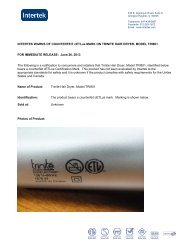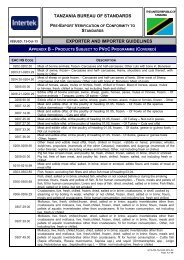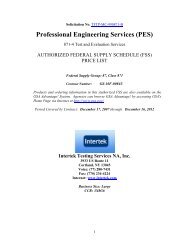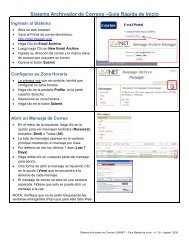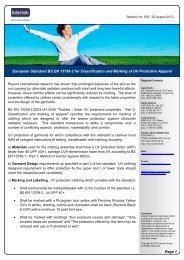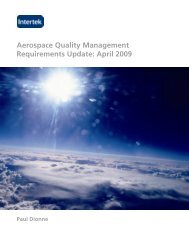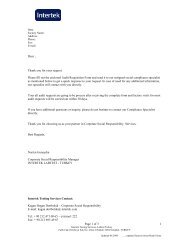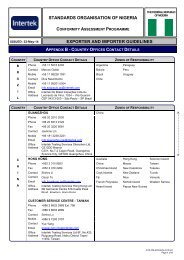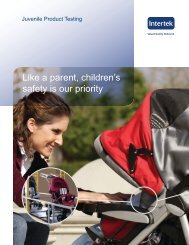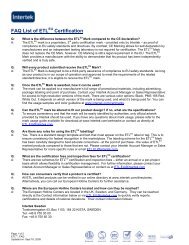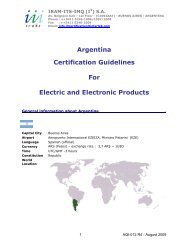Understanding the Machinery Directive (2006/42/EC) - Intertek
Understanding the Machinery Directive (2006/42/EC) - Intertek
Understanding the Machinery Directive (2006/42/EC) - Intertek
You also want an ePaper? Increase the reach of your titles
YUMPU automatically turns print PDFs into web optimized ePapers that Google loves.
<strong>Understanding</strong> <strong>the</strong> <strong>Machinery</strong> <strong>Directive</strong><br />
(<strong>2006</strong>/<strong>42</strong>/<strong>EC</strong>)<br />
<strong>Intertek</strong><br />
70 Codman Hill Road<br />
Boxborough, MA 01719<br />
icenter@intertek.com 1-800-WORLDLAB<br />
www.intertek.com
<strong>Understanding</strong> <strong>the</strong> <strong>Machinery</strong><br />
<strong>Directive</strong> (<strong>2006</strong>/<strong>42</strong>/<strong>EC</strong>)<br />
Index<br />
Introduction .................................................................................................................... 1<br />
Brief History.................................................................................................................... 2<br />
Overview: The <strong>Machinery</strong> <strong>Directive</strong> (<strong>2006</strong>/<strong>42</strong>/<strong>EC</strong>) ..................................................... 2<br />
Key Changes to <strong>the</strong> <strong>Directive</strong> ........................................................................................ 3<br />
1) Scope ........................................................................................................................3<br />
2) Exclusions ................................................................................................................ 4<br />
3) Partly Completed <strong>Machinery</strong> ................................................................................... 5<br />
4) Radiation & Hazardous Substances ......................................................................... 6<br />
5) Notified Bodies ........................................................................................................ 6<br />
6) Surveillance & Enforcement .................................................................................... 7<br />
7) ‘Under conditions that can reasonably be foreseen’ ................................................ 8<br />
8) Annex IV................................................................................................................. 9<br />
9) Lifting Equipment .................................................................................................. 10<br />
10) Safe ‘Transportation’ not just ‘handling’............................................................. 11<br />
11) Requirements on Ergonomics, Operating Positions and Seating......................... 11<br />
12) Instruction Documentation................................................................................... 12<br />
13) Symbols & Pictograms......................................................................................... 15<br />
Who is affected by this <strong>Directive</strong>............................................................................... 16<br />
Complications ............................................................................................................... 16<br />
Conformity Assessment................................................................................................ 16<br />
Conformity Assessment – Requirements.................................................................... 16<br />
Requirements: The Technical File.............................................................................. 18<br />
Requirements: The <strong>EC</strong> Declaration of Conformity .................................................. 18<br />
Conclusion ..................................................................................................................... 19<br />
Appendix: Process Flow Chart<br />
Introduction<br />
In this paper we will look at <strong>the</strong> <strong>Machinery</strong> <strong>Directive</strong> (<strong>2006</strong>/<strong>42</strong>/<strong>EC</strong>), and discuss <strong>the</strong><br />
differences between <strong>2006</strong>/<strong>42</strong>/<strong>EC</strong> and its predecessor 98/37/<strong>EC</strong>. We’ll also look at routes<br />
to ensure ongoing conformity.<br />
www.intertek.com 1
<strong>Understanding</strong> <strong>the</strong> <strong>Machinery</strong><br />
<strong>Directive</strong> (<strong>2006</strong>/<strong>42</strong>/<strong>EC</strong>)<br />
Brief History<br />
In 1985, a series of ‘New Approach Principles’ were introduced into <strong>the</strong> European<br />
Community (<strong>EC</strong>) that would enable <strong>the</strong> free movement of goods across <strong>the</strong> region.<br />
They laid out a set of market parameters for <strong>the</strong> <strong>EC</strong>, including Essential Health and<br />
Safety Requirements for workers in <strong>the</strong> Community and minimum product requirements<br />
for goods going on sale in <strong>the</strong> region.<br />
From <strong>the</strong>se principles, a number of specific <strong>Directive</strong>s were developed to govern<br />
particular types of products and operating characteristics, including:<br />
<br />
<br />
<br />
<br />
<br />
<br />
Low Voltage <strong>Directive</strong><br />
EMC <strong>Directive</strong><br />
<strong>Machinery</strong> <strong>Directive</strong><br />
ATEX (Explosive Atmospheres)<br />
Pressure Equipment <strong>Directive</strong><br />
Gas Appliances <strong>Directive</strong><br />
The <strong>Directive</strong>s establish specific minimum performance requirements, and products that<br />
meet <strong>the</strong>se are said to have a ‘presumption of conformity’. This can be validated<br />
through product assessment against harmonized Standards, ei<strong>the</strong>r by <strong>the</strong> party that plans<br />
to sell its product in <strong>the</strong> EU or on <strong>the</strong>ir behalf by a third-party assessment organization –<br />
such as an accredited certification body.<br />
Products that meet <strong>the</strong> essential requirements of <strong>the</strong> <strong>Directive</strong>s that govern <strong>the</strong>m can be<br />
placed on <strong>the</strong> market, but a Declaration of Conformity must be made. A technical file<br />
for <strong>the</strong> product must be available in <strong>the</strong> EU and <strong>the</strong> product must carry <strong>the</strong> mandated CE<br />
Marking, as required by <strong>the</strong> <strong>Directive</strong>s. Some of <strong>the</strong> <strong>Directive</strong>s, e.g. ATEX and Gas,<br />
also require that CE Marking for certain product types is supported by mandatory<br />
certification from a qualified body. On <strong>the</strong>se products, <strong>the</strong> CE mark is accompanied by<br />
<strong>the</strong> Notified Body number below <strong>the</strong> CE symbol. Compliance with <strong>the</strong>se regulations is<br />
<strong>the</strong>n enforced by surveillance activities carried out by member states.<br />
Now, <strong>the</strong> New Approach <strong>Directive</strong>s are under review, particularly relating to <strong>the</strong><br />
essential requirements of <strong>the</strong> harmonized Standards, <strong>the</strong> role of third party certification<br />
marks, and <strong>the</strong> role <strong>the</strong>y play in <strong>the</strong> compliance process. The goal is to streng<strong>the</strong>n<br />
market surveillance activities and enforcement.<br />
More information on <strong>the</strong> New Approach <strong>Directive</strong>s can be found at:<br />
http://www.newapproach.org/<strong>Directive</strong>s/Default.asp<br />
Overview: The <strong>Machinery</strong> <strong>Directive</strong> (<strong>2006</strong>/<strong>42</strong>/<strong>EC</strong>)<br />
www.intertek.com 2
<strong>Understanding</strong> <strong>the</strong> <strong>Machinery</strong><br />
<strong>Directive</strong> (<strong>2006</strong>/<strong>42</strong>/<strong>EC</strong>)<br />
<br />
<br />
The <strong>Directive</strong> has been put in place because:<br />
“The machinery sector is an important part of <strong>the</strong> engineering industry and is<br />
one of <strong>the</strong> industrial mainstays of <strong>the</strong> Community economy. The social cost of<br />
<strong>the</strong> large number of accidents caused by <strong>the</strong> use of machinery can be reduced by<br />
inherently safe design and construction of machinery and by proper installation<br />
and maintenance” (Paragraph 2)<br />
Article 2 of <strong>the</strong> <strong>Directive</strong> specifies <strong>the</strong> products that <strong>the</strong> <strong>Directive</strong> applies to:<br />
o an assembly, fitted with or intended to be fitted with a drive system o<strong>the</strong>r<br />
than directly applied human or animal effort, consisting of linked parts or<br />
components, at least one of which moves, and which are joined toge<strong>the</strong>r<br />
for a specific application<br />
o an assembly referred to in <strong>the</strong> first indent, missing only <strong>the</strong> components<br />
to connect it on site or to sources of energy and motion,<br />
o an assembly referred to in <strong>the</strong> first and second indents, ready to be<br />
installed and able to function as it stands only if mounted on a means of<br />
transport, or installed in a building or a structure,<br />
o assemblies of machinery referred to in <strong>the</strong> first, second and third indents<br />
or partly completed machinery<br />
o an assembly of linked parts or components, at least one of which moves<br />
and which are joined toge<strong>the</strong>r, intended for lifting loads and whose only<br />
power source is directly applied human effort;<br />
In all cases relevant provisions of o<strong>the</strong>r <strong>EC</strong> <strong>Directive</strong>s where <strong>the</strong>se are appropriate<br />
(EMC, ATEX etc) must be taken into account to achieve full compliance with <strong>the</strong><br />
<strong>Directive</strong> – including Health and Safety requirements (as indicated in paragraph 14)<br />
<strong>Directive</strong> <strong>2006</strong>/<strong>42</strong>/<strong>EC</strong> replaces 98/37/<strong>EC</strong> – adoption 29th June <strong>2006</strong><br />
<br />
<br />
<strong>2006</strong>/<strong>42</strong>/<strong>EC</strong> comes into force on 29th December 2009, with very limited<br />
exceptions*<br />
Old directive repealed - NO TRANSITION PERIOD*<br />
In <strong>the</strong> UK it is adopted under <strong>the</strong> new “<strong>Machinery</strong> Regulations 2008”<br />
(replacing “Supply of <strong>Machinery</strong> (Safety) Regulations 1992 (SI 1992/3073<br />
and amendments))”<br />
* Cartridge-operated fixing and o<strong>the</strong>r impact machinery, which were previously excluded –<br />
Transition to 29th June 2011<br />
Key Changes to <strong>the</strong> <strong>Directive</strong><br />
Recent changes to <strong>the</strong> <strong>Directive</strong> can be considered comprehensive as <strong>the</strong>y encompass a<br />
modified range of ‘machinery’. The changes consider product design as well as<br />
www.intertek.com 3
<strong>Understanding</strong> <strong>the</strong> <strong>Machinery</strong><br />
<strong>Directive</strong> (<strong>2006</strong>/<strong>42</strong>/<strong>EC</strong>)<br />
construction, and <strong>the</strong>y specify particular aspects of <strong>the</strong> required associated<br />
documentation needed for conformity. Even on-going surveillance and <strong>the</strong> role of<br />
Notified Bodies is explored fur<strong>the</strong>r. The key changes are as follows:<br />
1) Scope<br />
Previously <strong>the</strong> scope of <strong>Directive</strong> covered:<br />
<br />
<br />
<br />
<br />
<br />
<strong>Machinery</strong><br />
Interchangeable equipment<br />
Safety components<br />
Lifting accessories<br />
Removable mechanical transmission devices<br />
The <strong>Directive</strong> was extended to include:<br />
<br />
<br />
Chains, ropes and webbings<br />
Partly completed machinery<br />
2) Exclusions<br />
In <strong>the</strong> previous version of <strong>the</strong> <strong>Machinery</strong> <strong>Directive</strong> 98/37/<strong>EC</strong>, an extensive list of<br />
equipment was excluded from its scope. In <strong>2006</strong>/<strong>42</strong>/<strong>EC</strong> several of <strong>the</strong>se have been<br />
removed and o<strong>the</strong>rs clarified. Several new items have been added as well. The exclusion<br />
list now contains:<br />
<br />
<br />
<br />
<br />
<br />
<br />
<br />
<br />
<br />
<br />
<br />
Fairground/amusement park equipment<br />
<strong>Machinery</strong> for nuclear purposes<br />
Agricultural and forestry tractors*<br />
Motor vehicles and <strong>the</strong>ir trailers covered by <strong>Directive</strong> 70/156/E<strong>EC</strong> of 6 February<br />
1970*<br />
2 or 3 wheeled motor vehicles covered by <strong>Directive</strong> 2002/24/<strong>EC</strong> of 18 March<br />
2002*<br />
Motor vehicles intended for competition<br />
Means of transport by air, water or rail*<br />
Seagoing vessels and mobile offshore units<br />
<strong>Machinery</strong> designed for military or police purposes<br />
Mine Winding Gear<br />
<strong>Machinery</strong> intended to move performers during artistic performances<br />
*Equipment mounted on <strong>the</strong> excluded types of transportation however is NOT excluded from <strong>the</strong> scope of <strong>the</strong><br />
<strong>Directive</strong>.<br />
Exclusions include:<br />
www.intertek.com 4
<strong>Understanding</strong> <strong>the</strong> <strong>Machinery</strong><br />
<strong>Directive</strong> (<strong>2006</strong>/<strong>42</strong>/<strong>EC</strong>)<br />
<br />
<br />
<br />
Safety components intended to be used as spare parts to replace identical<br />
components and supplied by <strong>the</strong> manufacturer of <strong>the</strong> original machinery<br />
Weapons, including firearms<br />
<strong>Machinery</strong> specifically designed and constructed for research purposes for<br />
temporary use in laboratories<br />
Electrical and electronic products falling under <strong>Directive</strong> 73/23/E<strong>EC</strong> of 19<br />
February 1973 (including household appliances, ordinary office machinery, low<br />
voltage switchgear and control gear)**<br />
<br />
<br />
High Voltage Switchgear and control gear<br />
High Voltage Transformers<br />
** This equipment is specifically covered by <strong>the</strong> Low Voltage <strong>Directive</strong> <strong>2006</strong>/95/<strong>EC</strong><br />
Machines powered by human effort are not specifically excluded, nor are medical<br />
devices – but <strong>the</strong> latter are already covered by <strong>the</strong> Medical Devices <strong>Directive</strong><br />
93/<strong>42</strong>/E<strong>EC</strong>.<br />
3) Partly Completed <strong>Machinery</strong><br />
<strong>Directive</strong> <strong>2006</strong>/<strong>42</strong> <strong>EC</strong> makes provisions for partially completed machinery in a<br />
procedure that is outlined in Article 13<br />
“Procedure for partly completed machinery<br />
1. The manufacturer of partly completed machinery or his authorized<br />
representative shall, before placing it on <strong>the</strong> market, ensure that:<br />
(a) <strong>the</strong> relevant technical documentation described in Annex VII, part B<br />
is prepared;<br />
(b) assembly instructions described in Annex VI are prepared;<br />
(c) a declaration of incorporation described in Annex II, part 1, Section<br />
B has been drawn up.<br />
2. The assembly instructions and <strong>the</strong> declaration of incorporation shall<br />
accompany <strong>the</strong> partly completed machinery until it is incorporated into <strong>the</strong><br />
final machinery and shall <strong>the</strong>n form part of <strong>the</strong> technical file for that<br />
machinery.”<br />
ANNEX VI also makes a requirement for assembly instructions for partly completed<br />
machinery.<br />
“The assembly instructions for partly completed machinery must contain a<br />
description of <strong>the</strong> conditions which must be met with a view to correct<br />
incorporation in <strong>the</strong> final machinery, so as not to compromise safety and health.<br />
www.intertek.com 5
<strong>Understanding</strong> <strong>the</strong> <strong>Machinery</strong><br />
<strong>Directive</strong> (<strong>2006</strong>/<strong>42</strong>/<strong>EC</strong>)<br />
The assembly instructions must be written in an official Community language<br />
acceptable to <strong>the</strong> manufacturer of <strong>the</strong> machinery in which <strong>the</strong> partly completed<br />
machinery will be assembled, or to his authorized representative.<br />
Risk assessment documentation should be included in <strong>the</strong> technical file.<br />
Declaration of incorporation and assembly instructions for partly completed<br />
machinery incorporated into machinery are now required.”<br />
4) Radiation & Hazardous Substances<br />
In <strong>the</strong> <strong>Directive</strong>, <strong>the</strong> sections governing <strong>the</strong> risk to operators from both ionizing and<br />
non-ionizing radiation, as well as hazardous substances are significantly clearer and<br />
more extensive than those of its predecessor. They read:<br />
“1.5.10 Radiation<br />
Undesirable radiation emissions from <strong>the</strong> machinery must be eliminated or be<br />
reduced to levels that do not have adverse effects on persons.<br />
Any functional ionizing radiation emissions must be limited to <strong>the</strong> lowest level<br />
which is sufficient for <strong>the</strong> proper functioning of <strong>the</strong> machinery during setting,<br />
operation and cleaning. Where a risk exists, <strong>the</strong> necessary protective measures<br />
must be taken.<br />
Any functional non-ionizing radiation emissions during setting, operation and<br />
cleaning must be limited to levels that do not have adverse effects on persons.<br />
1.5.13 Emissions of Hazardous materials and substances<br />
<strong>Machinery</strong> must be designed and constructed in such a way that risks of<br />
inhalation, ingestion, contact with <strong>the</strong> skin, eyes and mucous membranes and<br />
penetration through <strong>the</strong> skin of hazardous materials and substances which it<br />
produces can be avoided.<br />
Where a hazard cannot be eliminated, <strong>the</strong> machinery must be so equipped that<br />
hazardous materials and substances can be contained, evacuated, precipitated by<br />
water spraying, filtered or treated by ano<strong>the</strong>r equally effective method.<br />
Where <strong>the</strong> process is not totally enclosed during normal operation of <strong>the</strong><br />
machinery, <strong>the</strong> devices for containment and/or evacuation must be situated in<br />
such a way as to have <strong>the</strong> maximum effect.”<br />
5) Notified Bodies<br />
Article 14 on <strong>the</strong> role of Notified Bodies defines <strong>the</strong> roles and responsibilities that a<br />
Notified Body plays in <strong>the</strong> conformity and surveillance process. One particular section<br />
of importance reads:<br />
www.intertek.com 6
<strong>Understanding</strong> <strong>the</strong> <strong>Machinery</strong><br />
<strong>Directive</strong> (<strong>2006</strong>/<strong>42</strong>/<strong>EC</strong>)<br />
2. The Member States shall ensure that <strong>the</strong> notified bodies are monitored<br />
regularly to check that <strong>the</strong>y comply at all times with <strong>the</strong> criteria set out in Annex<br />
XI. The notified body shall provide all relevant information on request,<br />
including budgetary documents, to enable <strong>the</strong> Member States to ensure that <strong>the</strong><br />
requirements of Annex XI are met.*<br />
Notified Bodies for <strong>the</strong> <strong>Machinery</strong> <strong>Directive</strong> will now explicitly be monitored by <strong>the</strong><br />
member states for impartiality, competence, processes and anti-bribery under <strong>the</strong><br />
<strong>Directive</strong>.<br />
Also new, is <strong>the</strong> provision for <strong>the</strong> appointing authorities of Notified Bodies, to exchange<br />
information. This will enable <strong>the</strong>m to bring greater continuity to <strong>the</strong> process of selection<br />
and appointment, and contribute to <strong>the</strong> uniform application of this <strong>Directive</strong> across <strong>the</strong><br />
community.<br />
6) Surveillance & Enforcement<br />
The combined clauses of Articles 4, 14, and 19 streng<strong>the</strong>n <strong>the</strong> surveillance and<br />
enforcement of <strong>the</strong> <strong>Directive</strong> for machines and incomplete machines. They also<br />
facilitate <strong>the</strong> sharing of information between member states, to make <strong>the</strong> process more<br />
rigorous across <strong>the</strong> EU.<br />
Article 4 leads with:<br />
1. Member States shall take all appropriate measures to ensure that machinery<br />
may be placed on <strong>the</strong> market and/or put into service only if it satisfies <strong>the</strong><br />
relevant provisions of this <strong>Directive</strong> and does not endanger <strong>the</strong> health and<br />
safety of persons and, where appropriate, domestic animals or property,<br />
when properly installed and maintained and used for its intended purpose or<br />
under conditions which can reasonably be foreseen.<br />
2. Member States shall take all appropriate measures to ensure that partly<br />
completed machinery can be placed on <strong>the</strong> market only if it satisfies <strong>the</strong><br />
relevant provisions of this <strong>Directive</strong>.<br />
3. Member States shall institute or appoint <strong>the</strong> competent authorities to monitor<br />
<strong>the</strong> conformity of machinery and partly completed machinery with <strong>the</strong><br />
provisions set out in paragraphs 1 and 2.<br />
4. Member States shall define <strong>the</strong> tasks, organization and powers of <strong>the</strong><br />
competent authorities referred to in paragraph 3 and shall notify <strong>the</strong><br />
Commission and o<strong>the</strong>r Member States <strong>the</strong>reof and also of any subsequent<br />
amendment”<br />
Paragraph 6 of Article 14 states:<br />
www.intertek.com 7
<strong>Understanding</strong> <strong>the</strong> <strong>Machinery</strong><br />
<strong>Directive</strong> (<strong>2006</strong>/<strong>42</strong>/<strong>EC</strong>)<br />
“6. If a notified body finds that relevant requirements of this <strong>Directive</strong> have not<br />
been met or are no longer met by <strong>the</strong> manufacturer or that an <strong>EC</strong> typeexamination<br />
certificate or <strong>the</strong> approval of a quality assurance system should not<br />
have been issued, it shall, taking account of <strong>the</strong> principle of proportionality,<br />
suspend or withdraw <strong>the</strong> certificate or <strong>the</strong> approval issued or place restrictions<br />
on it, giving detailed reasons, unless compliance with such requirements is<br />
ensured by <strong>the</strong> implementation of appropriate corrective measures by <strong>the</strong><br />
manufacturer.<br />
In <strong>the</strong> event of suspension or withdrawal of <strong>the</strong> certificate or <strong>the</strong> approval or of<br />
any restriction placed on it, or in cases where intervention by <strong>the</strong> competent<br />
authority may prove necessary, <strong>the</strong> notified body shall inform <strong>the</strong> competent<br />
authority pursuant to Article 4. The Member State shall inform <strong>the</strong> o<strong>the</strong>r<br />
Member States and <strong>the</strong> Commission without delay. An appeal procedure shall be<br />
available.*<br />
Article 19 adds:<br />
“Cooperation between Member States<br />
1. Member States shall take <strong>the</strong> appropriate measures to ensure that <strong>the</strong><br />
competent authorities referred to in Article 4(3) cooperate with each o<strong>the</strong>r and<br />
with <strong>the</strong> Commission and transmit to each o<strong>the</strong>r <strong>the</strong> information necessary to<br />
enable this <strong>Directive</strong> to be applied uniformly.<br />
2. The Commission shall provide for <strong>the</strong> organization of an exchange of<br />
experience between <strong>the</strong> competent authorities responsible for market<br />
surveillance in order to coordinate <strong>the</strong> uniform application of this <strong>Directive</strong>.”<br />
7) ‘Under conditions that can reasonably be foreseen’<br />
Previously, <strong>the</strong> <strong>Directive</strong>’s emphasis of <strong>the</strong> safety of machinery was within <strong>the</strong> context<br />
of its intended use or purpose. However, in <strong>the</strong> newer version of <strong>the</strong> <strong>Directive</strong> it is<br />
interesting to note that ‘foreseeable’ o<strong>the</strong>r use (or misuse) must also be taken into<br />
consideration. Paragraph 12 of <strong>Directive</strong> <strong>2006</strong>/<strong>42</strong> <strong>EC</strong> states:<br />
“The putting into service of machinery within <strong>the</strong> meaning of <strong>the</strong> <strong>Directive</strong> can<br />
relate only to <strong>the</strong> use of <strong>the</strong> machinery itself for its intended purpose or for a<br />
purpose which be reasonably foreseen.”<br />
This concept appears several times during <strong>the</strong> text of <strong>the</strong> <strong>Directive</strong> – most notably in<br />
Annex 1 in clause 1.1.2. c)<br />
c) When designing and constructing machinery and when drafting <strong>the</strong><br />
instructions, <strong>the</strong> manufacturer or his authorized representative must envisage not<br />
only <strong>the</strong> intended use of <strong>the</strong> machinery but also any reasonably foreseeable<br />
misuse <strong>the</strong>reof.<br />
www.intertek.com 8
<strong>Understanding</strong> <strong>the</strong> <strong>Machinery</strong><br />
<strong>Directive</strong> (<strong>2006</strong>/<strong>42</strong>/<strong>EC</strong>)<br />
The machinery must be designed and constructed in such a way as to prevent<br />
abnormal use, if such use would engender a risk. Where appropriate, <strong>the</strong><br />
instructions must draw <strong>the</strong> user's attention to ways — which experience has<br />
shown might occur — in which <strong>the</strong> machinery should not be used.<br />
Perhaps this can best be addressed by manufacturers and facility staff via a risk<br />
assessment, where ‘foreseen’ alternative uses for a machine can be highlighted and<br />
mitigated as necessary.<br />
Similarly, manufacturers must also take into account that some types of equipment will<br />
be utilized by non-professional operators, and so designers and builders will need to be<br />
aware of that when <strong>the</strong>y create <strong>the</strong> equipment. This should encourage inherently safer<br />
and more intuitive design.<br />
8) Annex IV<br />
Annex IV of <strong>the</strong> <strong>Machinery</strong> <strong>Directive</strong> defines categories of machinery to which <strong>the</strong><br />
Conformity Assessment routes outlined in Article 12 refer, creating 3 categories of<br />
equipment, Non-Annex IV <strong>Machinery</strong>, Annex IV <strong>Machinery</strong> and Safety Components<br />
and Incomplete <strong>Machinery</strong> – <strong>the</strong> latter we have already discussed.<br />
The requirements for Non Annex IV <strong>Machinery</strong> are:<br />
<br />
<br />
<br />
Self declaration<br />
Technical File<br />
That manufacturer takes all necessary measures to ensure that <strong>the</strong> manufacturing<br />
process ensures compliance with <strong>the</strong> Technical File and <strong>the</strong> <strong>Directive</strong><br />
The requirements for Annex IV <strong>Machinery</strong> using Harmonized Standards are:<br />
<br />
<br />
Machine manufactured in accordance with Harmonized Standards AND, <strong>the</strong>se<br />
standards meet <strong>the</strong> EHSR’s<br />
While <strong>the</strong> onus is on <strong>the</strong> manufacturers to ensure ‘state of <strong>the</strong> art’ <strong>the</strong>y must<br />
choose one of <strong>the</strong> following approaches:<br />
o Internal checks as Annex VIII<br />
o <strong>EC</strong> Type Examination by Notified Body and Internal checks as Annex<br />
VIII<br />
o Full Quality Assurance by Notified Body to Annex X<br />
o Onus on manufacturer to ensure ‘State of <strong>the</strong> Art’<br />
The requirements for Annex IV <strong>Machinery</strong> using Non-Harmonized Standards are:<br />
www.intertek.com 9
<strong>Understanding</strong> <strong>the</strong> <strong>Machinery</strong><br />
<strong>Directive</strong> (<strong>2006</strong>/<strong>42</strong>/<strong>EC</strong>)<br />
<br />
<br />
Machine manufactured in accordance with Non-Harmonized Standards or<br />
Harmonized standards only partially applied, or if Harmonized standards do not<br />
exist or <strong>the</strong>se standards meet do not address all <strong>the</strong> EHSR’s<br />
While <strong>the</strong> onus is on <strong>the</strong> manufacturers to ensure ‘state of <strong>the</strong> art’ <strong>the</strong>y must<br />
choose one of <strong>the</strong> following approaches:<br />
o <strong>EC</strong> Type Examination by Notified Body and Internal checks as Annex<br />
VIII<br />
o Full Quality Assurance by Notified Body to Annex X<br />
Full Quality Assurance to Annex X by Notified Body is a robust solution<br />
9) Lifting Equipment<br />
The <strong>Directive</strong>’s requirements for lifting equipment and lifting accessories are also<br />
clearer and more extensive than those of <strong>the</strong> prior <strong>Directive</strong>. Within Article 24, Lifts<br />
<strong>Directive</strong> 95/16/<strong>EC</strong> was modified to align with <strong>the</strong> scope of <strong>2006</strong>/<strong>42</strong>/<strong>EC</strong> as <strong>the</strong><br />
<strong>Machinery</strong> <strong>Directive</strong> covers this type of equipment. Some types of lifting equipment are<br />
still excluded - this is detailed in Article 24, paragraph 3:<br />
<br />
<br />
<br />
<br />
<br />
<br />
<br />
<br />
<br />
<br />
<br />
lifting appliances whose speed is not greater than 0,15 m/s,<br />
construction site hoists,<br />
cableways, including funicular railways,<br />
lifts specially designed and constructed for military or police purposes,<br />
lifting appliances from which work can be carried out,<br />
mine winding gear,<br />
lifting appliances intended for lifting performers during artistic performances,<br />
lifting appliances fitted in means of transport,<br />
lifting appliances connected to machinery and intended exclusively for access to<br />
workstations including maintenance and inspection points on <strong>the</strong> machinery,<br />
rack and pinion trains,<br />
escalators and mechanical walkways<br />
Later in Annex 4.3.3 <strong>the</strong> particular requirements for lifting equipment that are included<br />
in <strong>the</strong> scope of <strong>the</strong> <strong>Directive</strong> are detailed. The old version of <strong>the</strong> <strong>Directive</strong> required that<br />
nominal loads be marked on machinery. Now this must be <strong>the</strong> maximum load.<br />
For lifting machinery in particular, a new clause d) has also been added to <strong>the</strong><br />
instruction content requirements –<br />
“4.4.2. Lifting machinery<br />
Lifting machinery must be accompanied by instructions containing information<br />
on:<br />
d) where appropriate, a test report detailing <strong>the</strong> static and dynamic tests carried<br />
out by or for <strong>the</strong> manufacturer or his authorized representative”<br />
www.intertek.com 10
<strong>Understanding</strong> <strong>the</strong> <strong>Machinery</strong><br />
<strong>Directive</strong> (<strong>2006</strong>/<strong>42</strong>/<strong>EC</strong>)<br />
10) Safe ‘Transportation’ not just ‘handling’.<br />
Annex 1.1.5 makes reference to how ‘transportation’ of <strong>the</strong> machinery, not just<br />
‘handling’ should be taken into consideration. This explicitly extends <strong>the</strong> protection of<br />
<strong>the</strong> <strong>Directive</strong> to those involved in <strong>the</strong> freight and logistical transfer of equipment, as<br />
well as those who might handle it on site. Specifically:<br />
“During <strong>the</strong> transportation of <strong>the</strong> machinery and/or its component parts, <strong>the</strong>re<br />
must be no possibility of sudden movements or of hazards due to instability as<br />
long as <strong>the</strong> machinery and/or its component parts are handled in accordance with<br />
<strong>the</strong> instructions.<br />
Where <strong>the</strong> weight, size or shape of machinery or its various component parts<br />
prevents <strong>the</strong>m from being moved by hand, <strong>the</strong> machinery or each component<br />
part must:<br />
<br />
<br />
<br />
ei<strong>the</strong>r be fitted with attachments for lifting gear, or<br />
be designed so that it can be fitted with such attachments, or<br />
be shaped in such a way that standard lifting gear can easily be attached.”<br />
11) Requirements on Ergonomics, Operating Positions and Seating<br />
These were less explicit in <strong>the</strong> previous version of <strong>the</strong> <strong>Directive</strong>, but <strong>the</strong>y now have a<br />
greater alignment with health and safety best practices:<br />
“1.1.6. Ergonomics<br />
Under <strong>the</strong> intended conditions of use, <strong>the</strong> discomfort, fatigue and physical and<br />
psychological stress faced by <strong>the</strong> operator must be reduced to <strong>the</strong> minimum<br />
possible, taking into account ergonomic principles such as:<br />
o allowing for <strong>the</strong> variability of <strong>the</strong> operator's physical dimensions,<br />
strength and stamina,<br />
o providing enough space for movements of <strong>the</strong> parts of <strong>the</strong> operator's<br />
body,<br />
o avoiding a machine-determined work rate,<br />
o avoiding monitoring that requires lengthy concentration,<br />
o adapting <strong>the</strong> man/machinery interface to <strong>the</strong> foreseeable characteristics<br />
of <strong>the</strong> operators.<br />
1.1.7. Operating positions<br />
The operating position must be designed and constructed in such a way as to<br />
avoid any risk due to exhaust gases and/or lack of oxygen.<br />
If <strong>the</strong> machinery is intended to be used in a hazardous environment presenting<br />
risks to <strong>the</strong> health and safety of <strong>the</strong> operator, or if <strong>the</strong> machinery itself gives rise<br />
www.intertek.com 11
<strong>Understanding</strong> <strong>the</strong> <strong>Machinery</strong><br />
<strong>Directive</strong> (<strong>2006</strong>/<strong>42</strong>/<strong>EC</strong>)<br />
to a hazardous environment, adequate means must be provided to ensure that <strong>the</strong><br />
operator has good working conditions and is protected against any foreseeable<br />
hazards.<br />
Where appropriate, <strong>the</strong> operating position must be fitted with an adequate cabin<br />
that is designed, constructed and/or equipped to fulfil <strong>the</strong> above requirements.<br />
The exit must allow rapid evacuation. Moreover, when applicable, an emergency<br />
exit must be provided in a direction which is different from <strong>the</strong> usual exit.<br />
1.1.8. Seating<br />
Where appropriate and where <strong>the</strong> working conditions so permit, work stations<br />
constituting an integral part of <strong>the</strong> machinery must be designed for <strong>the</strong><br />
installation of seats.<br />
If <strong>the</strong> operator is intended to sit during operation and <strong>the</strong> operating position is an<br />
integral part of <strong>the</strong> machinery, <strong>the</strong> seat must be provided with <strong>the</strong> machinery.<br />
The operator's seat must enable him to maintain a stable position. Fur<strong>the</strong>rmore,<br />
<strong>the</strong> seat and its distance from <strong>the</strong> control devices must be capable of being<br />
adapted to <strong>the</strong> operator.<br />
If <strong>the</strong> machinery is subject to vibrations, <strong>the</strong> seat must be designed and<br />
constructed in such a way as to reduce <strong>the</strong> vibrations transmitted to <strong>the</strong> operator<br />
at <strong>the</strong> lowest level that is reasonably possible. The seat mountings must<br />
withstand all stresses to which <strong>the</strong>y can be subjected. Where <strong>the</strong>re is no floor<br />
beneath <strong>the</strong> feet of <strong>the</strong> operator, footrests covered with a slip-resistant material<br />
must be provided.”<br />
12) Instruction Documentation<br />
The requirements for instructions for assembly demand much more detail than<br />
previously.<br />
“1.7.4 All machinery must be accompanied by instructions in <strong>the</strong> official<br />
Community language or languages of <strong>the</strong> Member State in which it is placed on<br />
<strong>the</strong> market and/or put into service. The instructions accompanying <strong>the</strong><br />
machinery must be ei<strong>the</strong>r ‘Original instructions’ or a ‘Translation of <strong>the</strong> original<br />
instructions’, in which case <strong>the</strong> translation must be accompanied by <strong>the</strong> original<br />
instructions.<br />
By way of exception, <strong>the</strong> maintenance instructions intended for use by<br />
specialized personnel mandated by <strong>the</strong> manufacturer or his authorized<br />
representative may be supplied in only one Community language which <strong>the</strong><br />
specialized personnel understand.”<br />
Interestingly, <strong>the</strong> concept of ‘under conditions that can be reasonably foreseen’ appears<br />
again in <strong>the</strong> instructions annex, requiring <strong>the</strong> manufacturer should take any foreseeable<br />
www.intertek.com 12
<strong>Understanding</strong> <strong>the</strong> <strong>Machinery</strong><br />
<strong>Directive</strong> (<strong>2006</strong>/<strong>42</strong>/<strong>EC</strong>)<br />
misuse into consideration when drafting <strong>the</strong>ir instructions, despite <strong>the</strong> fact that it is still<br />
misuse and could be hazardous.<br />
“1.74.1 General principles for <strong>the</strong> drafting of instructions<br />
(c) The contents of <strong>the</strong> instructions must cover not only <strong>the</strong> intended use of <strong>the</strong><br />
machinery but also take into account any reasonably foreseeable misuse<br />
<strong>the</strong>reof.”<br />
The description of what must be included in <strong>the</strong> instructions reads:<br />
“1.7.4.2. Contents of <strong>the</strong> instructions<br />
Each instruction manual must contain, where applicable, at least <strong>the</strong> following<br />
information:<br />
(a) <strong>the</strong> business name and full address of <strong>the</strong> manufacturer and of his authorized<br />
representative;<br />
(b) <strong>the</strong> designation of <strong>the</strong> machinery as marked on <strong>the</strong> machinery itself, except<br />
for <strong>the</strong> serial number (see section 1.7.3);<br />
(c) <strong>the</strong> <strong>EC</strong> declaration of conformity, or a document setting out <strong>the</strong> contents of<br />
<strong>the</strong> <strong>EC</strong> declaration of conformity, showing <strong>the</strong> particulars of <strong>the</strong> machinery,<br />
not necessarily including <strong>the</strong> serial number and <strong>the</strong> signature;<br />
(d) a general description of <strong>the</strong> machinery;<br />
(e) <strong>the</strong> drawings, diagrams, descriptions and explanations necessary for <strong>the</strong> use,<br />
maintenance and repair of <strong>the</strong> machinery and for checking its correct<br />
functioning;<br />
(f) a description of <strong>the</strong> workstation(s) likely to be occupied by operators;<br />
(g) a description of <strong>the</strong> intended use of <strong>the</strong> machinery;<br />
(h) warnings concerning ways in which <strong>the</strong> machinery must not be used that<br />
experience has shown might occur;<br />
(i) assembly, installation and connection instructions, including drawings,<br />
diagrams and <strong>the</strong> means of attachment and <strong>the</strong> designation of <strong>the</strong> chassis or<br />
installation on which <strong>the</strong> machinery is to be mounted;<br />
(j) instructions relating to installation and assembly for reducing noise or<br />
vibration;<br />
www.intertek.com 13
<strong>Understanding</strong> <strong>the</strong> <strong>Machinery</strong><br />
<strong>Directive</strong> (<strong>2006</strong>/<strong>42</strong>/<strong>EC</strong>)<br />
(k) instructions for <strong>the</strong> putting into service and use of <strong>the</strong> machinery and, if<br />
necessary, instructions for <strong>the</strong> training of operators;<br />
(l) information about <strong>the</strong> residual risks that remain despite <strong>the</strong> inherent safe<br />
design measures, safeguarding and complementary protective measures<br />
adopted;<br />
(m) instructions on <strong>the</strong> protective measures to be taken by <strong>the</strong> user, including,<br />
where appropriate, <strong>the</strong> personal protective equipment to be provided;<br />
(n) <strong>the</strong> essential characteristics of tools which may be fitted to <strong>the</strong> machinery;<br />
(o) <strong>the</strong> conditions in which <strong>the</strong> machinery meets <strong>the</strong> requirement of stability<br />
during use, transportation, assembly, dismantling when out of service,<br />
testing or foreseeable breakdowns;<br />
(p) instructions with a view to ensuring that transport, handling and storage<br />
operations can be made safely, giving <strong>the</strong> mass of <strong>the</strong> machinery and of its<br />
various parts where <strong>the</strong>se are regularly to be transported separately;<br />
(q) <strong>the</strong> operating method to be followed in <strong>the</strong> event of accident or breakdown;<br />
if a blockage is likely to occur, <strong>the</strong> operating method to be followed so as to<br />
enable <strong>the</strong> equipment to be safely unblocked;<br />
(r) <strong>the</strong> description of <strong>the</strong> adjustment and maintenance operations that should be<br />
carried out by <strong>the</strong> user and <strong>the</strong> preventive maintenance measures that should<br />
be observed;<br />
(s) instructions designed to enable adjustment and maintenance to be carried<br />
out safely, including <strong>the</strong> protective measures that should be taken during<br />
<strong>the</strong>se operations;<br />
(t) <strong>the</strong> specifications of <strong>the</strong> spare parts to be used, when <strong>the</strong>se affect <strong>the</strong> health<br />
and safety of operators;<br />
(u) <strong>the</strong> following information on airborne noise emissions:<br />
o <strong>the</strong> A-weighted emission sound pressure level at workstations, where this<br />
exceeds 70 dB(A); where this level does not exceed 70 dB(A), this fact<br />
must be indicated,<br />
o <strong>the</strong> peak C-weighted instantaneous sound pressure value at workstations,<br />
where this exceeds 63 Pa (130 dB in relation to 20 μPa),<br />
o <strong>the</strong> A-weighted sound power level emitted by <strong>the</strong> machinery, where <strong>the</strong><br />
A-weighted emission sound pressure level at workstations exceeds 80<br />
dB(A). These values must be ei<strong>the</strong>r those actually measured for <strong>the</strong><br />
www.intertek.com 14
<strong>Understanding</strong> <strong>the</strong> <strong>Machinery</strong><br />
<strong>Directive</strong> (<strong>2006</strong>/<strong>42</strong>/<strong>EC</strong>)<br />
In <strong>the</strong> case of very large machinery, instead of <strong>the</strong> A-weighted sound power<br />
level, <strong>the</strong> A-weighted emission sound pressure levels at specified positions<br />
around <strong>the</strong> machinery may be indicated.<br />
Where <strong>the</strong> harmonized standards are not applied, sound levels must be measured<br />
using <strong>the</strong> most appropriate method for <strong>the</strong> machinery. Whenever sound emission<br />
values are indicated, <strong>the</strong> uncertainties surrounding <strong>the</strong>se values must be<br />
specified. The operating conditions of <strong>the</strong> machinery during measurement and<br />
<strong>the</strong> measuring methods used must be described.<br />
Where <strong>the</strong> workstation(s) are undefined or cannot be defined, A-weighted sound<br />
pressure levels must be measured at a distance of 1 meter from <strong>the</strong> surface of <strong>the</strong><br />
machinery, and at a height of 1.6 meters from <strong>the</strong> floor or access platform. The<br />
position and value of <strong>the</strong> maximum sound pressure must be indicated.<br />
Where specific Community <strong>Directive</strong>s lay down o<strong>the</strong>r requirements for <strong>the</strong><br />
measurement of sound pressure levels or sound power levels, those <strong>Directive</strong>s<br />
must be applied and <strong>the</strong> corresponding provisions of this section shall not apply;<br />
(v) where machinery is likely to emit non-ionizing radiation which may cause<br />
harm to persons, in particular persons with active or non-active implantable<br />
medical devices, information concerning <strong>the</strong> radiation emitted for <strong>the</strong><br />
operator and exposed persons”<br />
13) Symbols & Pictograms<br />
Related to <strong>the</strong> specific requirements for detailed machine instructions is <strong>the</strong> new section<br />
in Annex 1 on <strong>the</strong> use of symbols and pictograms in information and warnings. With <strong>the</strong><br />
increasing migration of workers between member states, local languages may not<br />
necessarily be understood by machine operators, so <strong>the</strong> <strong>Directive</strong> makes provision for<br />
non-textual communication on <strong>the</strong> machinery so risks and warnings can be easily<br />
understood by all.<br />
1.7.1 Information and warnings on <strong>the</strong> machinery<br />
Information and warnings on <strong>the</strong> machinery should preferably be provided in <strong>the</strong><br />
form of readily understandable symbols or pictograms. Any written or verbal<br />
information and warnings must be expressed in an official Community language<br />
or languages, which may be determined in accordance with <strong>the</strong> Treaty by <strong>the</strong><br />
Member State in which <strong>the</strong> machinery is placed on <strong>the</strong> market and/or put into<br />
service and may be accompanied, on request, by versions in any o<strong>the</strong>r official<br />
Community language or languages understood by <strong>the</strong> operators.<br />
www.intertek.com 15
<strong>Understanding</strong> <strong>the</strong> <strong>Machinery</strong><br />
<strong>Directive</strong> (<strong>2006</strong>/<strong>42</strong>/<strong>EC</strong>)<br />
Who is affected by this <strong>Directive</strong><br />
<br />
<br />
<br />
<br />
<br />
Manufacturers<br />
Machine Builders<br />
Manufacturers performing final assembly and CE Marking of machinery<br />
Agents and representatives placing imported machinery within <strong>the</strong> EU<br />
Manufacturers of special purpose tools, rigs and skids<br />
Complications<br />
<br />
<br />
No list of harmonized standards has yet been published<br />
EN954 (Safety of <strong>Machinery</strong>, Safety related parts of control systems) has a date<br />
of Withdrawal of November 2009<br />
Introduction of ISO EN 13489<br />
Conformity Assessment<br />
The first task is to conduct a Gap Analysis between <strong>the</strong> old and new version of <strong>the</strong><br />
<strong>Directive</strong>:<br />
<br />
<br />
<br />
<br />
<br />
What standards are you using now<br />
Are <strong>the</strong>y still up to date<br />
Do transposed harmonized standards exist<br />
What is <strong>the</strong> current ‘State of <strong>the</strong> Art’<br />
Does a risk assessment exist for <strong>the</strong> machine<br />
If all of <strong>the</strong>se are up to date, <strong>the</strong>n only a Declaration of Conformity change is required<br />
<br />
<br />
Self Declaration (for certain categories)<br />
Third Party Certification and Role of Notified Body<br />
Conformity Assessment – Requirements<br />
Paragraph 20 of <strong>the</strong> <strong>Directive</strong> states:<br />
www.intertek.com 16
<strong>Understanding</strong> <strong>the</strong> <strong>Machinery</strong><br />
<strong>Directive</strong> (<strong>2006</strong>/<strong>42</strong>/<strong>EC</strong>)<br />
“Manufacturers should retain full responsibility for certifying <strong>the</strong> conformity of<br />
<strong>the</strong>ir machinery to <strong>the</strong> provisions of this <strong>Directive</strong>. Never<strong>the</strong>less, for certain<br />
types of machinery having a higher risk factor, a stricter certification procedure<br />
is desirable.”<br />
Paragraph 23 additionally states:<br />
“The manufacturers or his authorized representative should also ensure that a<br />
risk assessment is carried out for <strong>the</strong> machinery which he wishes to place on <strong>the</strong><br />
market. For this purpose, he should determine which are <strong>the</strong> essential health and<br />
safety requirements applicable to his machinery and in respect of which he must<br />
take measures”<br />
According to <strong>the</strong> conformity assessment process, <strong>the</strong> first thing a manufacturer should<br />
do is a risk assessment on <strong>the</strong> proposed product. Annex 1 helpfully states what this<br />
should include:<br />
“1. The manufacturer of machinery or his authorized representative must ensure<br />
that a risk assessment is carried out in order to determine <strong>the</strong> health and safety<br />
requirements which apply to <strong>the</strong> machinery. The machinery must <strong>the</strong>n be<br />
designed and constructed taking into account <strong>the</strong> results of <strong>the</strong> risk assessment.<br />
By <strong>the</strong> iterative process of risk assessment and risk reduction referred to above,<br />
<strong>the</strong> manufacturer or his authorized representative shall:<br />
<br />
<br />
<br />
<br />
<br />
determine <strong>the</strong> limits of <strong>the</strong> machinery, which include <strong>the</strong> intended use and<br />
any reasonably foreseeable misuse <strong>the</strong>reof,<br />
identify <strong>the</strong> hazards that can be generated by <strong>the</strong> machinery and <strong>the</strong><br />
associated hazardous situations,<br />
estimate <strong>the</strong> risks, taking into account <strong>the</strong> severity of <strong>the</strong> possible injury or<br />
damage to health and <strong>the</strong> probability of its occurrence,<br />
evaluate <strong>the</strong> risks, with a view to determining whe<strong>the</strong>r risk reduction is<br />
required, in accordance with <strong>the</strong> objective of this <strong>Directive</strong>,<br />
eliminate <strong>the</strong> hazards or reduce <strong>the</strong> risks associated with <strong>the</strong>se hazards by<br />
application of protective measures, in <strong>the</strong> order of priority established in<br />
section 1.1.2(b).”<br />
Then a manufacturer should review all <strong>the</strong> <strong>Directive</strong>s that are applicable to <strong>the</strong>ir<br />
products – not just <strong>the</strong> <strong>Machinery</strong> <strong>Directive</strong>. If <strong>the</strong>y need guidance on which <strong>Directive</strong>s<br />
<strong>the</strong>se are, <strong>the</strong>ir test and certification partner will be happy to identify <strong>the</strong>m. These are<br />
likely to include <strong>the</strong> ATEX <strong>Directive</strong>, EMC <strong>Directive</strong>, <strong>the</strong> Energy Related Products<br />
<strong>Directive</strong>, <strong>the</strong> Pressure Equipment <strong>Directive</strong> and <strong>the</strong> Gas Appliances <strong>Directive</strong>.<br />
Once <strong>the</strong> correct <strong>Directive</strong>s have been identified and <strong>the</strong> design team has used <strong>the</strong><br />
guidance of <strong>the</strong> <strong>Directive</strong> to design <strong>the</strong> machine for maximum compliance, <strong>the</strong><br />
www.intertek.com 17
<strong>Understanding</strong> <strong>the</strong> <strong>Machinery</strong><br />
<strong>Directive</strong> (<strong>2006</strong>/<strong>42</strong>/<strong>EC</strong>)<br />
applicable harmonized Standards governing that machine should be applied to <strong>the</strong> test<br />
process. Again, <strong>the</strong>se can be identified by a national Standards making body (from<br />
where <strong>the</strong> Standards can be purchased), or from a test and certification partner.<br />
Once <strong>the</strong> product has been tested to confirm compliance, <strong>the</strong>n a test report and a<br />
Technical File (including <strong>the</strong> risk assessment, test reports etc) and a manufacturers<br />
‘Declaration of Conformity’ for <strong>the</strong> machine needs to be generated.<br />
Then CE Marking can be applied to <strong>the</strong> machine and it can be shipped with <strong>the</strong><br />
declaration and <strong>the</strong> instructions for assembly and use.<br />
Requirements: The Technical File<br />
The technical file is a mandatory requirement and should include:<br />
<br />
<br />
<br />
<br />
<br />
<br />
<br />
<br />
<br />
Equipment’s general description<br />
Drawings/Service manual<br />
Information on standards applied<br />
Test reports / Photos<br />
Rationale for compliance including reference to Harmonized or o<strong>the</strong>r Technical<br />
Standards<br />
Copy of Declaration of Conformity<br />
Changes control procedure<br />
ISO 9001 – Approval Related Procedures<br />
Any o<strong>the</strong>r safety related documents/procedures<br />
The file does not have to be held in <strong>the</strong> EU but must be capable of ‘being assembled and<br />
made available’ by <strong>the</strong> person designated on <strong>the</strong> <strong>EC</strong> D of C<br />
Requirements: The <strong>EC</strong> Declaration of Conformity<br />
The declaration of conformity must identify:<br />
<br />
<br />
<br />
<br />
<br />
<br />
Manufacturer<br />
Responsible person (by name and job title)<br />
Exact product type/name<br />
Year of affixation of CE Marking<br />
List of applicable standards<br />
Place and Date<br />
www.intertek.com 18
<strong>Understanding</strong> <strong>the</strong> <strong>Machinery</strong><br />
<strong>Directive</strong> (<strong>2006</strong>/<strong>42</strong>/<strong>EC</strong>)<br />
It is <strong>the</strong> written declaration by <strong>the</strong> manufacturer or his authorized representative that:<br />
The equipment to which <strong>the</strong> CE Mark has been affixed, complies with <strong>the</strong> <strong>Machinery</strong><br />
<strong>Directive</strong>.<br />
A flow chart illustrating <strong>the</strong> Conformity Assessment Routes can be found in Appendix 1<br />
of this document.<br />
Conclusion<br />
<strong>Machinery</strong> <strong>Directive</strong> <strong>2006</strong>/<strong>42</strong>/<strong>EC</strong> is as much about improving <strong>the</strong> design of a Machine,<br />
as it is about manufacturing it, building it correctly and using it safely. Annex 1,<br />
paragraph 1 sums up <strong>the</strong> purpose of <strong>the</strong> entire <strong>Directive</strong> succinctly.<br />
“1.1.2. Principles of safety integration<br />
(a) <strong>Machinery</strong> must be designed and constructed so that it is fitted for its<br />
function, and can be operated, adjusted and maintained without putting persons<br />
at risk when <strong>the</strong>se operations are carried out under <strong>the</strong> conditions foreseen but<br />
also taking into account any reasonably foreseeable misuse <strong>the</strong>reof.<br />
The aim of measures taken must be to eliminate any risk throughout <strong>the</strong><br />
foreseeable lifetime of <strong>the</strong> machinery including <strong>the</strong> phases of transport,<br />
assembly, dismantling, disabling and scrapping.”<br />
Help is always available from your partner test and certification body - who will be<br />
happy to go through <strong>the</strong> requirements, processes and options with you. Their experts<br />
can also conduct a gap analysis to identify your current areas of conformity risk and<br />
give you advice on any additional testing, paperwork updates or quality assurance you<br />
might need.<br />
To review a copy of <strong>Machinery</strong> <strong>Directive</strong> (<strong>2006</strong>/<strong>42</strong>/<strong>EC</strong>) for yourself, visit <strong>the</strong> Europa<br />
Website at: http://ec.europa.eu/enterprise/mechan_equipment/machinery/revdir.htm<br />
For more information on specific testing and certification information, please contact <strong>Intertek</strong> at<br />
1-800-WORLDLAB, email icenter@intertek.com, or visit our website at www.intertek-etlsemko.com.<br />
This publication is copyright <strong>Intertek</strong> and may not be reproduced or transmitted in any form in whole or in part without <strong>the</strong> prior<br />
written permission of <strong>Intertek</strong>. While due care has been taken during <strong>the</strong> preparation of this document, <strong>Intertek</strong> cannot be held<br />
responsible for <strong>the</strong> accuracy of <strong>the</strong> information herein or for any consequence arising from it. Clients are encouraged to seek<br />
<strong>Intertek</strong>’s current advice on <strong>the</strong>ir specific needs before acting upon any of <strong>the</strong> content.<br />
www.intertek.com 19
<strong>Understanding</strong> <strong>the</strong> <strong>Machinery</strong> <strong>Directive</strong> (<strong>2006</strong>/<strong>42</strong>/<strong>EC</strong>)<br />
Appendix 1:<br />
Conformity Assessment Routes<br />
<strong>Machinery</strong> <strong>Directive</strong> <strong>2006</strong>/<strong>42</strong> Process Flow Chart<br />
Non-Annex IV<br />
<strong>Machinery</strong><br />
Annex IV <strong>Machinery</strong> and<br />
Safety Components<br />
Incomplete <strong>Machinery</strong><br />
Standards used<br />
Harmonised Standard<br />
used as defined in<br />
Article 7(2)<br />
Non Harmonised<br />
Standard used or<br />
Harmonised Standard<br />
only partly used<br />
Manufacturers<br />
Choice<br />
Manufacturers<br />
Choice<br />
Internal checks<br />
Annex VIII<br />
Internal checks<br />
Annex VIII<br />
<strong>EC</strong> Type Examination<br />
by NB and Internal<br />
checks per point 3 of<br />
Annex VIII<br />
Full Quality Assurance<br />
Annex X<br />
By NB<br />
<strong>EC</strong> Type Examination<br />
by NB and Internal<br />
checks per point 3 of<br />
Annex VIII<br />
Full Quality Assurance<br />
Annex X<br />
By NB<br />
Tech doc’s Annex VII<br />
Instructions Annex II<br />
Manufacturers Declaration of Conformity<br />
Manufacturers<br />
Declaration of<br />
Incorporation<br />
www.intertek.com 1



